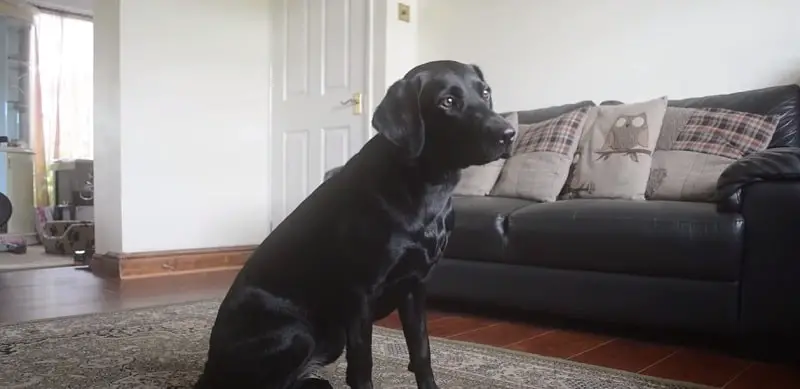Few things can be as shocking for a first-time dog owner as their pet first going into heat. There are just so many variables and questions when it comes to length, care, and beyond.
A Labrador’s heat usually lasts two to four weeks and happens roughly every six months to one year apart. Out of these weeks, your Labrador will be fertile for five to fourteen days, but you should be ready for symptoms and to apply special care during the whole time.
That said, at the end of the day, there are still countless questions that you must have as an owner moving forward, Today we’ll focus on answering as much as we can in regards to the health of your Labrador during their period, what phases do they go through and which special care you should have with them. It might sound long but once you grasp it’ll come as second nature, so stick with us through this article.
What are the stages of a dog in heat?
The first thing we need to do before we approach the specifics of Labrador heats is to understand how it works for dogs in general, as there’s a fair amount of difference from what we are used to with human women.
While unspayed dogs like women have a fertility cycle that determines when they can enter pregnancy, it’s not identical to the menstrual cycle we see with people.
After reaching their sexual maturity, female dogs start experiencing an estrus cycle composed of 4 unique stages. This season is always at play for a dog, and when a dog enters a specific stage in that cycle, they are considered to be in “heat.”
The first stage of a dog’s heat is called Proestrus which lasts up to seventeen days and marks the start of the upcoming heat season.
When Preostrus starts, the dog’s body begins a hormonal process that results in more estrogen production. As a result of this, your dog will start to bleed.
This vaginal discharge is natural and shouldn’t be a sign of alarm on its own; This will also be accompanied by extensive peeing, which one again is part of the process.
During Proestrus, your dog is starting to tell males that she’s entering her fertile period, but it’s unlikely that males will chase or mount her. Likewise, she’s not fertile yet as Proestrus is just the opening act,
Estrus is the second stage of the cycle and the shortest overall. At this point, your dog is completely fertile, and she’s ready to get pregnant.
This stage is most apparent by the change in tone and color of her discharges. This peak period of infertility rarely lasts more than seven days.
Eventually, your dog will enter Diestrus, your dog will stop bleeding altogether, and her fertile period will end for the time being.
If she isn’t pregnant, then all the extra nutrients produced at this point will be reabsorbed, and her cycle will continue as usual.
Finally, your dog will enter Anestrus which is a period of sexual and hormonal inactivity. Altogether the four stages of Estrus tend to sum up 180 days, which means that a dog’s period should, in theory, happen every six months. However, as we’ll see next, this isn’t as clear-cut as the theory assumes.
How often do labs come in heat?
Going by the above numbers, we should assume that labradors have two fertile periods every year on the clock. However, while this is the commonly agreed-on average, the actual frequency can vary drastically from dog to dog.
Some labradors will enter heat on the clock every six months and continue this way during all of their sexually mature life. But some labradors will see longer Anestrus stages which will completely turn those calculations off the table.
Some labs can go as long as eight months between heat cycles, and in some extreme cases, they will only go in heat once every year.
Just like with humans, everybody is different, and since the Estrus cycle is much longer than menstruation, it’ll take some time for the peculiarities of your lab to be apparent.
After their first Estrus, your main concern should be to remain attentive. Please pay close attention to their house or bed so you can identify bleeding on time.
Your dog might start Proestrus regularly, or they might have a more spontaneous cycle. One way or another, this isn’t something that should worry you. It’s just part of what makes your friend unique.
What do you do when your Labrador gets her period?
By now, we have a good idea of how long do labradors have their period, what constitutes their heat cycle and what are the key signs to look for as an early warning.
But what should we be doing as owners? What can we do to ensure our dog is as comfortable as possible while this is going on?
The first thing we need to do is to understand how a dog feels while they are experiencing heat. While in humans, menstruation can be a painful process, the same doesn’t necessarily apply to dogs.
Generally speaking, we have no conclusive proof that dogs experience cramps or similar abdominal pains during their heat. However, it’s not uncommon for dogs to whine or bark when they experience their heat, so what are they experiencing?
While there’s no set rule on how dogs will react as their heat begins, your Labrador will certainly begin acting differently.
In some cases, your lab will become despondent and appear as if she ran out of energy for no reason. However, other labs can turn into the complete opposite, becoming increasingly fidgety as their heat continues.
Biologically heat is a very complex process for any dog, and their biological instinct is, after all, to go outside and mate. Your dog’s temperament will affect this considerably, but the neighborhood can also play a role.
Even if other dogs aren’t immediately around your lab, it doesn’t mean they won’t be aware of each other. Dogs have much better senses than we do, and they can be aware of each other even from afar.
As such, your lab can be aware that potential mates are out there and get anxious about it.

For the time being, we’ll assume that you plan to keep your dog away from pregnancy, as preparing for that would be a completely different guide. And with that in mind, the first thing you should do is to isolate your Labrador.
Heat can be like a rowdy rebellious phase for dogs, except that every dog you come across will get into it during this time.
Male dogs are far more pushy and even aggressive when they know a female in heat is around. As such, taking your lab into walks is a risk not only for her but for every dog owner you pass.
Nobody wants to be on a regular walk, only for a female in heat to throw a park or vet into chaos.
As we’ve seen, your dog is physically fine, and you shouldn’t be concerned about any physical symptoms. On top of that, as we’ve seen, the actual fertile days of a dog are rather short, so it’s perfectly fine to sit this time out at home.
That said, you should take greater care than usual to ensure they remain at home during this time. Some dogs have been known to escape from their houses to find a mate, which can completely ruin all of your plans and precautions.
Be careful when going in or out of your home, and don’t keep your dog in a place where she can easily leave or other dogs enter.
As long as her heat lasts, it is ideal to find a place indoors for your dog to weather through her heat. Don’t keep any sliding doors or low windows open, and if your dog does attempt to escape, do consider keeping her leashed at home.
The smell of a labrador’s discharges can prove pungent inf left n their own, so make sure to clean up often to avoid any extra discomfort for you and your dog.
As a whole, it shouldn’t be a hard process, but depending on where you are keeping your dog, it might be a good idea to pad the floor with some extra newspapers.
And, of course, make sure to wash your dog once all is said and done. Some dogs will be calm enough to allow you to clean them mid-heat, but this won’t be the case for every Labrador.
If your lab already looks agitated, then don’t push her. Just wait for the tide to calm down, and then give her a good rinse so she feels renovated and can get rid of any remaining odors.
As a whole, heat is more about preparation ad having a suitable place to keep your dog than anything else. Don’t get stressed, and don’t burn yourself out. You have all the info you need to ace your dog’s period.
Table Of Contents
